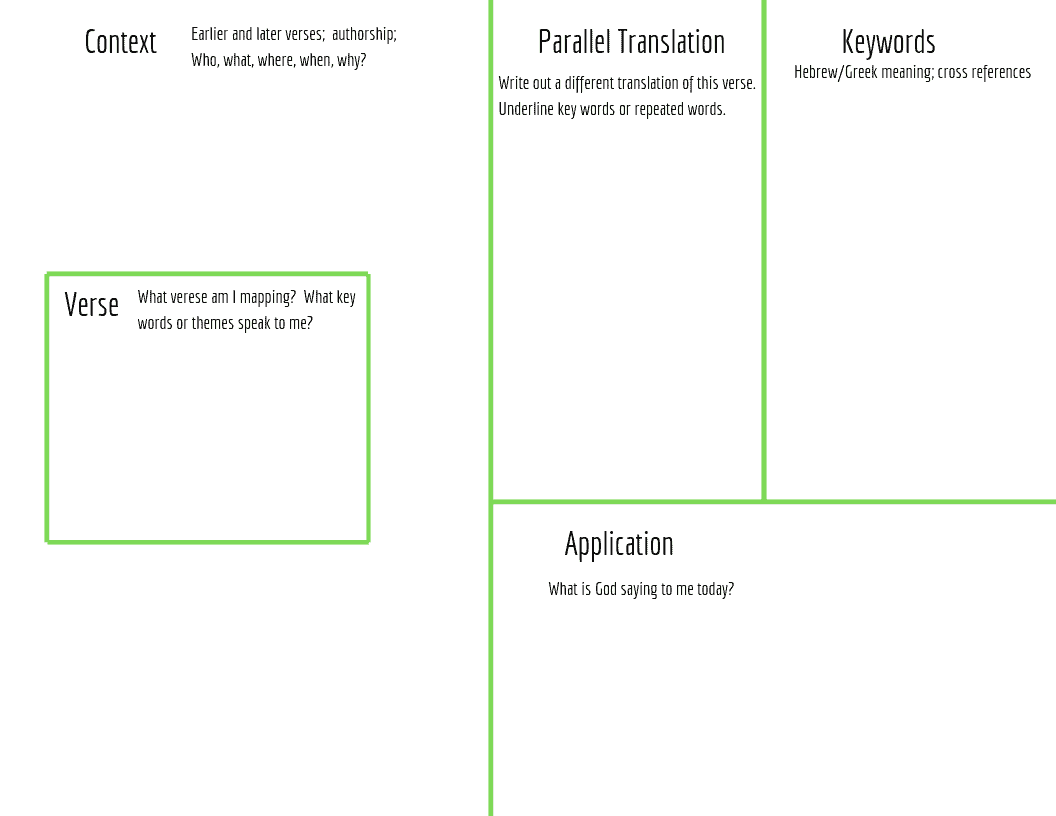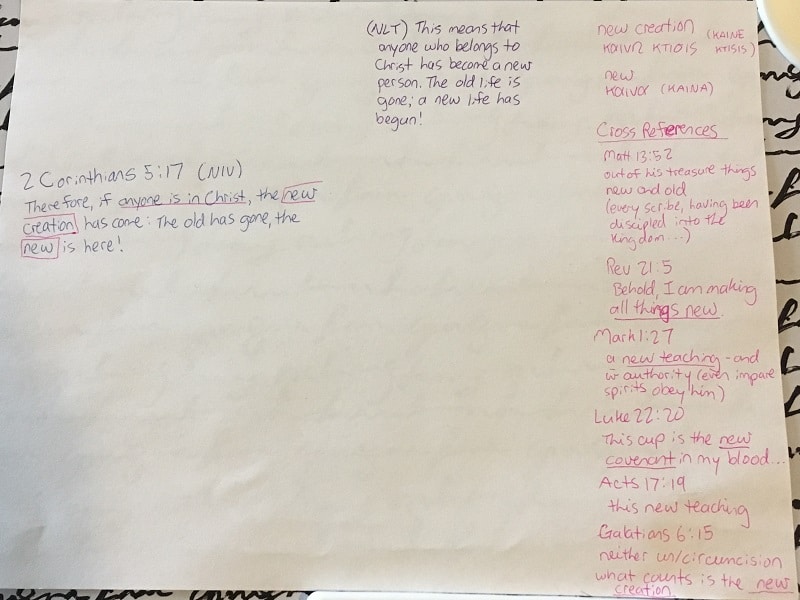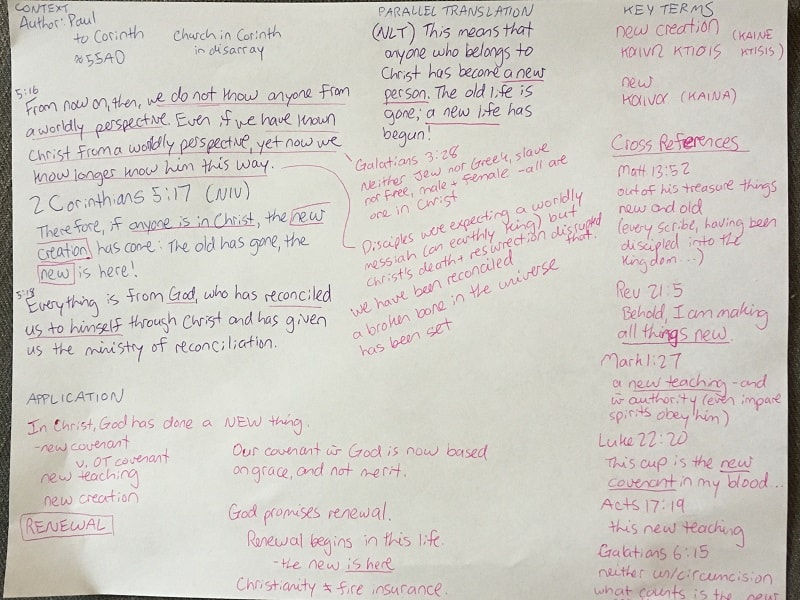Verse mapping is an excellent way to dive deeper into your favourite passages of Scripture, and to deepen your understanding of the truths that we find in the Bible.
I stumbled across verse mapping almost by accident, and I decided to try out this technique on one of the promises that God gives us in Scripture:
Therefore, if anyone is in Christ, the new creation has come: The old has gone, the new is here! (2 Corinthians 5:17)
I am fascinated by this concept of renewal, that God brings us not only salvation from death through Jesus Christ, but a renewal of our whole selves here and now.
This concept of renewal is captured in this passage from 2 Corinthians. In Christ, we are made new. (How cool is that?)

What is Bible Verse Mapping?
Bible verse mapping is a way of studying Scripture that helps you to dive deep into the word of God in just a few steps.
Verse mapping involves uncovering the historical context, transliteration, translation, connotation, and theological framework of a verse in the Bible...
...which basically means that you are looking at the verse in context. You are uncovering:
- the meaning of the original language,
- where those same terms are used elsewhere,
- what the passage might have meant to the original audience,
- and what it means to you today.
In doing verse mapping, you'll get to pick out and analyze different words, themes, and the history behind each verse that you are studying.
While this might sound intimidating (How do I discover the history behind a verse? And what if I don't know Greek or Hebrew?!) it can be made quite simple if you use a few tools like a study Bible or commentary and a concordance.
How to Do Verse Mapping for Beginners
If you are brand new to verse mapping, or perhaps haven't even heard the term "verse mapping" until now, there's no need to fear. Diving deeper into Scripture is easier than most people think.
In just a few steps, you can be mining the Bible for truths that will help you to not only understand the Bible better, but also perhaps to understand yourself better.
Gathering and Getting Started
There are just a few materials that you need to get started with Bible verse mapping. Basically, all you need is a Bible, a place to record your insights, something to record with, and some commentary/language tools.
Here's my list:
- a journal
- a Bible
- a concordance (Biblehub.com has a super convenient concordance built in)
- a commentary
- a language tool (Biblehub.com is an amazing tool for looking at the original language even when you have no language skills)
- markers/pens/highlighters
- time
How to Do Bible Verse Mapping Step by Step
Bible verse mapping can be broken down into 5 super simple steps.
- Choose a verse.
- Look at different translations.
- Highlight or circle the words you want to clarify.
- Look at the verse in context.
- Apply the verse to your life right now.

You can download your free printable verse mapping guide here if you want some help keeping all your thoughts in order. (Or you can freehand it like I did below.)
Step 1. Choose a verse
How do you pick a verse to map? Try...
- a favourite verse
- a topic you’re interested in (hope, strength, peace, etc.)
- a verse in your current Bible study
- a difficult verse that you’d like help deciphering
- one of the promises of God that we find in Scripture
Step 2. Look at different translations.
- Record at least one parallel translation of your chosen verse.
- Underline key phrases or words repeated.
Reading the verse in a different translation can give you greater insight into the passage. Many words in the original Hebrew or Greek have multiple ways that they could be translated into English. Looking at different translations of a Bible passage is a quick and easy way to see how different translators read the passage (and what may be missing from a certain translation).

Step 3. Highlight or circle the words you want to clarify.
- look up Hebrew or Greek meaning (Biblehub.com)
- look up cross-references for the key terms (Biblehub.com or a concordance)
Many words in Hebrew and Greek can be translated by multiple words in English. Looking up the original word can sometimes shed more light on a passage in Scripture. It can help you understand the depth and breadth of the passage. It can also reveal certain themes and undertones that may be lost when the word is translated into English.
A tool like BibleHub.com makes looking up the Hebrew and Greek - and understanding it - super simple, even if you have zero prior experience with ancient languages.
To look up the original language of a word, and to find cross references using Biblehub.com:
- Click on "interlin", which will give you the Greek or the Hebrew side-by-side with the English.
- If you hover over the word with your mouse (on your laptop), you'll get the definition of the word.
- Click on the word that you want to investigate to see where else in the Bible it appears.
Looking at cross-references will help you to trace themes throughout Scripture and help you better understand your verse.
Step 4. Look at the verse in context.
Questions to ask yourself at this stage:
- What is happening in this verse? To whom?
- Who is the author? What was the context?
- Who is in the verse, what is happening to them, where and when are these events taking place, and why does it matter?
- Who was the author of the passage and when was it written? (When a passage was written may be different than when the story occurred, since much of what we find in the Bible was passed on as an oral tradition for years before it was written down.)
Read and record the verses before and after your verse. These verses may reveal new insight into Scripture and greater understanding of the character of God.
Looking at the context also helps to avoid taking the verse out of the original context in which it was intended (and possibly missing the real meaning of the verse).
Step 5. Apply the passage to your life right now.
Questions to ask yourself at this stage:
- What is God saying to me today?
- How can I apply this to my life?
You can also personalize the verse by substitute 3rd person words with your name.

